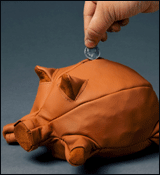

It starts as a shriveled bag that grows as coins are deposited and eventually reaches the size of a stuffed animal. The owner must slice the belly stitches to reach the coins. The pig can be resewn and thus restart its life cycle.
The intent is to create a visceral means to inspire people to save instead of spending by investing them in the growth of the pig.








Ideation
This project arose from the desire to change people's perception of money by reinforcing the analogy of livestock and currency and the sense of investment that comes from it.
A sense of investment can be as complex as customizing one's car or as simple as treating one's favorite clothes with care but the most apt analogy would be that of a role-playing-game avatar. Progression within a RPG leads to increased customization and a sense of ownership of the character. My challenge was to recreate this interaction and to give people the conscious choice to harvest what they have gathered.
Prototype
I used the form of a traditional piggy bank so that I could draw upon its symbolism. The only difference between it and a traditional piggy bank is that it's made out of a pliable material. Leather was chosen as the final material because it implies an actual pig's skin and because it holds up better under the weight of coins. Early models featured a small belly slit that resulted in vulgar connotations when it sat with its legs spread and coins pouring out.








